Hydrological Effects of Urban Green Space on Stormwater Runoff Reduction in Luohe, China
Abstract
1. Introduction
2. Materials and Methods
2.1. Study Area
2.2. i-Tree Hydro
2.3. Rainfall Interception Model in i-Tree Hydro
2.4. Data Processing
2.4.1. Required Input Data
2.4.2. Four Scenarios Creation
3. Results and Discussion
3.1. Total Runoff Generation
3.2. Pervious and Impervious Runoff Generation
3.3. Rainfall Interception Effects
3.4. Seasonal Variation in Rainfall Effects on Interception
3.4.1. Per Rain Event Precipitation Effects on Interception during Leaf-On Season
3.4.2. Per Rain Event Precipitation Effects on Interception during Leaf-Off Season
3.5. Rain Event Duration and Intensity Effects on Interception
3.6. Limitation in This Research
4. Conclusions
Future Research
Author Contributions
Funding
Acknowledgments
Conflicts of Interest
References
- McGrane, S.J. Impacts of urbanisation on hydrological and water quality dynamics, and urban water management: A review. Hydrol. Sci. J. 2016, 61, 2295–2311. [Google Scholar] [CrossRef]
- Arnold, C.L.; Gibbons, C.J. Impervious Surface Coverage: The Emergence of a Key Environmental Indicator. J. Am. Plan. Assoc. 1996, 62, 243–258. [Google Scholar] [CrossRef]
- Cheng, S.-J.; Wang, R.-Y. An approach for evaluating the hydrological effects of urbanization and its application. Hydrol. Process. 2002, 16, 1403–1418. [Google Scholar] [CrossRef]
- Liu, W.; Chen, W.; Peng, C. Assessing the effectiveness of green infrastructures on urban flooding reduction: A community scale study. Ecol. Model. 2014, 291, 6–14. [Google Scholar] [CrossRef]
- Zhang, B.; Xie, G.-D.; Li, N.; Wang, S. Effect of urban green space changes on the role of rainwater runoff reduction in Beijing, China. Landsc. Urban Plan. 2015, 140, 8–16. [Google Scholar] [CrossRef]
- Zölch, T.; Henze, L.; Keilholz, P.; Pauleit, S. Regulating urban surface runoff through nature-based solutions—An assessment at the micro-scale. Environ. Res. 2017, 157, 135–144. [Google Scholar] [CrossRef]
- Mell, I.C. Can green infrastructure promote urban sustainability? Proc. Inst. Civ. Eng. Eng. Sustain. 2009, 162, 23–34. [Google Scholar] [CrossRef]
- Chang, J.; Qu, Z.; Xu, R.; Pan, K.; Xu, B.; Min, Y.; Ren, Y.; Yang, G.; Ge, Y. Assessing the ecosystem services provided by urban green spaces along urban center-edge gradients. Sci. Rep. 2017, 7, 11226. [Google Scholar] [CrossRef]
- Szumacher, I. Functions of Urban Greenspace and Ecosystem Services. Misc. Geogr. 2011, 15, 123–129. [Google Scholar] [CrossRef]
- Vargas-Hernández, J.G.; Pallagst, K.; Zdunek-Wielgołaska, J. Urban Green Spaces as a Component of an Ecosystem. In Handbook of Engaged Sustainability; Marques, J., Ed.; Springer International Publishing: Cham, Switzerland, 2018; pp. 1–32. [Google Scholar]
- Bertram, C.; Rehdanz, K. The role of urban green space for human well-being. Ecol. Econ. 2015, 120, 139–152. [Google Scholar] [CrossRef]
- Kim, G.; Miller, P.A.; Nowak, D.J. Assessing urban vacant land ecosystem services: Urban vacant land as green infrastructure in the City of Roanoke, Virginia. Urban For. Urban Green. 2015, 14, 519–526. [Google Scholar] [CrossRef]
- Armson, D.; Stringer, P.; Ennos, A. The effect of street trees and amenity grass on urban surface water runoff in Manchester, UK. Urban For. Urban Green. 2013, 12, 282–286. [Google Scholar] [CrossRef]
- Yao, L.; Chen, L.; Wei, W.; Sun, R. Potential reduction in urban runoff by green spaces in Beijing: A scenario analysis. Urban For. Urban Green. 2015, 14, 300–308. [Google Scholar] [CrossRef]
- Xiao, Q.F.; McPherson, E.G.; Ustin, S.L.; Grismer, M.E.; Simpson, J.R. Winter rainfall interception by two mature open-grown trees in Davis, California. Hydrol. Proces. 2000, 14, 763–784. [Google Scholar] [CrossRef]
- Kim, G.; Coseo, P. Urban Park Systems to Support Sustainability: The Role of Urban Park Systems in Hot Arid Urban Climates. Forests 2018, 9, 439. [Google Scholar] [CrossRef]
- Mei, C.; Liu, J.; Wang, H.; Yang, Z.; Ding, X.; Shao, W. Integrated assessments of green infrastructure for flood mitigation to support robust decision-making for sponge city construction in an urbanized watershed. Sci. Total. Environ. 2018, 639, 1394–1407. [Google Scholar] [CrossRef]
- Nytch, C.J.; Meléndez-Ackerman, E.J.; Pérez, M.-E.; Ortiz-Zayas, J.R. Rainfall interception by six urban trees in San Juan, Puerto Rico. Urban Ecosyst. 2018, 22, 103–115. [Google Scholar] [CrossRef]
- Chen, J. Rapid urbanization in China: A real challenge to soil protection and food security. Catena 2007, 69, 1–15. [Google Scholar] [CrossRef]
- Winsemius, H.C.; Aerts, J.C.J.H.; Van Beek, L.P.H.; Bierkens, M.; Bouwman, A.; Jongman, B.; Kwadijk, J.C.J.; Ligtvoet, W.; Lucas, P.L.; Van Vuuren, D.P.; et al. Global drivers of future river flood risk. Nat. Clim. Chang. 2015, 6, 381–385. [Google Scholar] [CrossRef]
- Chen, Y.; Zhou, H.; Zhang, H.; Du, G.; Zhou, J. Urban flood risk warning under rapid urbanization. Environ. Res. 2015, 139, 3–10. [Google Scholar] [CrossRef]
- Schreider, S.Y.; Smith, D.I.; Jakeman, A. Climate Change Impacts on Urban Flooding. Clim. Chang. 2000, 47, 91–115. [Google Scholar] [CrossRef]
- MOHURD. Technical Guidance for Sponge City Construction—Low Impact Development Stormwater System Construction. Available online: http://www.mohurd.gov.cn/wjfb/201411/t20141102_219465.html (accessed on 18 February 2019).
- Zhang, Y.S. Sponge City Theory and its Application in Landscape. World Constr. 2017, 6, 29. [Google Scholar] [CrossRef]
- Shao, W.; Zhang, H.; Liu, J.; Yang, G.; Chen, X.; Yang, Z.; Huang, H. Data Integration and its Application in the Sponge City Construction of CHINA. Procedia Eng. 2016, 154, 779–786. [Google Scholar] [CrossRef]
- Wang, J.; Endreny, T.; Nowak, D.J. Mechanistic Simulation of Tree Effects in an Urban Water Balance Model. J. Am. Water Resour. Assoc. 2008, 44, 75–85. [Google Scholar] [CrossRef]
- Arnold, J.; Srinivasan, R.; Muttiah, R.S.; Allen, P.M. Continental scale simulation of the hydrologic balance. Am. Water Resour. Assoc. 1999, 35, 1037–1051. [Google Scholar] [CrossRef]
- Gironás, J.; Roesner, L.; Rossman, L.A.; Davis, J. A new applications manual for the Storm Water Management Model (SWMM). Environ. Model. Softw. 2010, 25, 813–814. [Google Scholar] [CrossRef]
- Yang, Y.; Endreny, T.; Nowak, D. Simulating Urban Tree Effects on Air, Water, and Heat Pollution Mitigation: iTree-Hydro Model; AGU Fall Meeting Abstracts. December 2011. Available online: https://ui.adsabs.harvard.edu/abs/2011AGUFM.B31B0323Y/abstract (accessed on 16 February 2019).
- Stephan, E.; Endreny, T.; Nowak, D. Development of Nutrient Model for i-Tree Hydro using Sampling Results from the Mianus River Watershed; AGU Fall Meeting Abstracts. December 2013. Available online: https://ui.adsabs.harvard.edu/abs/2013AGUFM.B13F0571S/abstract (accessed on 16 February 2019).
- Kirnbauer, M.; Baetz, B.; Kenney, W. Estimating the stormwater attenuation benefits derived from planting four monoculture species of deciduous trees on vacant and underutilized urban land parcels. Urban For. Urban Green. 2013, 12, 401–407. [Google Scholar] [CrossRef]
- Lefrançois, C.B. Designing Effective Stormwater Management Policies: The Role of the Urban Forest and Impervious Cover in Vancouver, B.C. Ph.D. Thesis, University of British Columbia, Vancouver, BC, Canada, 2015. [Google Scholar]
- Wen, L.; Weiping, C.; Chi, P. Modeling the Effects of Green Infrastructure on Storm Water Runoff Reduction on Community Scale. Acta Ecol. Sin. 2016, 36, 6. [Google Scholar] [CrossRef]
- Lega, M.; Endreny, T.; Brebbia, C.A.; Itoh, H. Quantifying the environmental impact of pollutant plumes from coastal rivers with remote sensing and river basin modelling. Int. J. Sustain. Dev. Plan. 2016, 11, 651–662. [Google Scholar] [CrossRef]
- Bodnaruk, E.; Kroll, C.; Yang, Y.; Hirabayashi, S.; Nowak, D.; Endreny, T. Where to plant urban trees? A spatially explicit methodology to explore ecosystem service tradeoffs. Landsc. Urban Plan. 2017, 157, 457–467. [Google Scholar] [CrossRef]
- Stephan, E. Development of a Parsimonious Urban Landscape Nutrient Model using Representations of Terrestrial Denitrification Controls. Ph.D. Thesis, State University of New York, New York, NY, USA, 2017. [Google Scholar]
- Bautista Avila, D.S. Modelación del ciclo hidrológico urbano en la localidad de Fontibón con I-TREE hydro. Master’s Thesis, University of Santo Tomas, Bogotá, Colombia, 2018. [Google Scholar]
- Jermyn, C. An Analysis of Runoff Ratios Across Urbanizing Gradients. Honors Thesis, State University of New York, Albany, NY, USA, 2018. [Google Scholar]
- Bautista, D.; Peña-Guzmán, C.A. Simulating the Hydrological Impact of Green Roof Use and an Increase in Green Areas in an Urban Catchment with i-Tree: A Case Study with the Town of Fontibón in Bogotá, Colombia. Resources 2019, 8, 68. [Google Scholar] [CrossRef]
- Rutter, A.; Kershaw, K.; Robins, P.; Morton, A.J. A predictive model of rainfall interception in forests, 1. Derivation of the model from observations in a plantation of Corsican pine. Agric. Meteorol. 1971, 9, 367–384. [Google Scholar] [CrossRef]
- Rutter, A.J.; Morton, A.J.; Robins, P.C. Predictive model of rainfall interception in forests. II. generalization of model and comparison with observations in some coniferous and hardwood stands. J. Appl. Ecol. 1975, 12, 367–380. [Google Scholar] [CrossRef]
- Gash, J.; Lloyd, C.; Lachaud, G. Estimating sparse forest rainfall interception with an analytical model. J. Hydrol. 1995, 170, 79–86. [Google Scholar] [CrossRef]
- Valente, F.; David, J.S.; Gash, J. Modelling interception loss for two sparse eucalypt and pine forests in central Portugal using reformulated Rutter and Gash analytical models. J. Hydrol. 1997, 190, 141–162. [Google Scholar] [CrossRef]
- Kim, G. Assessing Urban Forest Structure, Ecosystem Services, and Economic Benefits on Vacant Land. Sustainibility 2016, 8, 679. [Google Scholar] [CrossRef]
- EPA. EPA’s Methodology to Calculate Baseline Estimates of Impervious Area (IA) and Directly Connected Impervious Area (DCIA) for Massachusetts Communities. Available online: https://www3.epa.gov/region1/npdes/stormwater/ma/IA-DCIA-Calculation-Methodology.pdf (accessed on 18 February 2019).
- Yang, F. Study on Building and Application of Henan Province Soil Database. Master’s Thesis, Henan Agricultural University, Zhengzhou, China, 2008. [Google Scholar]
- Tsai, Y.H.; Stow, D.A.; Weeks, J.R. Comparison of Object-Based Image Analysis Approaches to Mapping New Buildings in Accra, Ghana Using Multi-Temporal QuickBird Satellite Imagery. Int. J. Remote Sens. 2011, 3, 2707–2726. [Google Scholar] [CrossRef]
- O’Neill, S. Measuring Urban Forest Canopy Effects on Stormwater Runoff in Guelph, Ontario. Master’s Thesis, The University of Guelph, Guelph, ON, Canada, 2018. [Google Scholar]
- LI, P.-W.; LI, G.-C.; Chen, L.; Yuan, X.-Z.; Xu, F. Analysis of Shenzhen’s vege-tation: Flood control and ecological benefit. J. Nat. Resour. 2009, 24, 1223–1233. [Google Scholar]
- Zhou, Y. Research on Urban Green Space System Design in Sponge City. Urban Rural Constr. 2017, 6, 29. [Google Scholar]
- Mentens, J.; Raes, D.; Hermy, M. Green roofs as a tool for solving the rainwater runoff problem in the urbanized 21st century? Landsc. Urban Plan. 2006, 77, 217–226. [Google Scholar] [CrossRef]
- Marengo, B.; Cahill, T.; Wible, D.; Marm, C.; Johnstone, R. Developing Green Streets Prototypes to Reduce Combined Sewer Overflows for Cincinnati, Ohio. In World Environmental and Water Resources Congress 2009: Great Rivers; Starrett, S., Ed.; ASCE: Reston, VA, USA, 2009; pp. 1–10. [Google Scholar]
- Inkiläinen, E.N.; McHale, M.R.; Blank, G.B.; James, A.; Nikinmaa, E. The role of the residential urban forest in regulating throughfall: A case study in Raleigh, North Carolina, USA. Landsc. Urban Plan. 2013, 119, 91–103. [Google Scholar] [CrossRef]
- Day, S.D.; Dickinson, S.B. Managing Stormwater for Urban Sustainability Using Trees and Structural Soils; Virginia Polytechnic Institute and State University: Blacksburg, VA, USA, 2008; pp. 1–63. [Google Scholar]
- Coville, R.; Endreny, T.; Nowak, D.J. Modeling the Impact of Urban Trees on Hydrology. In Forest-Water Interactions; Levia, D.F., Carlyle-Moses, D.E., Iida, S.i., Michalzik, B., Nanko, K., Tischer, A., Eds.; Springer: Cham, Switzerland, 2020; Volume 240, pp. 459–487. [Google Scholar]
- Toba, T.; Ohta, T. An observational study of the factors that influence interception loss in boreal and temperate forests. J. Hydrol. 2005, 313, 208–220. [Google Scholar] [CrossRef]
- Šraj, M.; Brilly, M.; Mikoš, M. Rainfall interception by two deciduous Mediterranean forests of contrasting stature in Slovenia. Agric. For. Meteorol. 2008, 148, 121–134. [Google Scholar] [CrossRef]
- Ghimire, C.P.; Bruijnzeel, L.A.; Lubczynski, M.W.; Ravelona, M.; Zwartendijk, B.W.; Van Meerveld, H.J.I. Measurement and modeling of rainfall interception by two differently aged secondary forests in upland eastern Madagascar. J. Hydrol. 2017, 545, 212–225. [Google Scholar] [CrossRef]
- Livesley, S.J.; Baudinette, B.; Glover, D. Rainfall interception and stem flow by eucalypt street trees—The impacts of canopy density and bark type. Urban For. Urban Green. 2014, 13, 192–197. [Google Scholar] [CrossRef]
- Xiao, Q.; McPherson, E.G. Surface Water Storage Capacity of Twenty Tree Species in Davis, California. J. Environ. Qual. 2016, 45, 188–198. [Google Scholar] [CrossRef]
- Návar, J.; Bryan, R.B. Fitting the analytical model of rainfall interception of Gash to individual shrubs of semi-arid vegetation in northeastern México. Agric. For. Meteorol. 1994, 68, 133–143. [Google Scholar] [CrossRef]
- Crockford, R.; Richardson, D. Partitioning of rainfall into throughfall, stemflow and interception: Effect of forest type, ground cover and climate. Hydrol. Process. 2000, 14, 2903–2920. [Google Scholar] [CrossRef]
- Levia, D.; Herwitz, S. Interspecific variation of bark water storage capacity of three deciduous tree species in relation to stemflow yield and solute flux to forest soils. Catena 2005, 64, 117–137. [Google Scholar] [CrossRef]
- Xiao, Q.; McPherson, E.G. Rainfall interception of three trees in Oakland, California. Urban Ecosyst. 2011, 14, 755–769. [Google Scholar] [CrossRef]
- Asadian, Y.; Weiler, M. A New Approach in Measuring Rainfall Interception by Urban Trees in Coastal British Columbia. Water Qual. Res. J. 2009, 44, 16–25. [Google Scholar] [CrossRef]
- Li, X.; Xiao, Q.; Niu, J.; Dymond, S.; Van Doorn, N.S.; Yu, X.; Xie, B.; Lv, X.; Zhang, K.; Li, J. Process-based rainfall interception by small trees in Northern China: The effect of rainfall traits and crown structure characteristics. Agric. For. Meteorol. 2016, 218, 65–73. [Google Scholar] [CrossRef]
- Kermavnar, J.; Vilhar, U. Canopy precipitation interception in urban forests in relation to stand structure. Urban Ecosyst. 2017, 20, 1373–1387. [Google Scholar] [CrossRef]
- Carlyle-Moses, D.E.; Gash, J.H.C. Rainfall Interception Loss by Forest Canopies. In Forest Hydrology and Biogeochemistry: Synthesis of Past Research and Future Directions; Levia, D., Carlyle-Moses, D., Tanaka, T., Eds.; Springer: Cham, Switzerland, 2011; Volume 216, pp. 407–423. [Google Scholar]
- Fletcher, T.; Andrieu, H.; Hamel, P. Understanding, management and modelling of urban hydrology and its consequences for receiving waters: A state of the art. Adv. Water Resour. 2013, 51, 261–279. [Google Scholar] [CrossRef]
- Zipper, S.C.; Schatz, J.; Kucharik, C.J.; Loheide, S. Urban heat island-induced increases in evapotranspirative demand. Geophys. Res. Lett. 2017, 44, 873–881. [Google Scholar] [CrossRef]
- Xiao, Q.; McPherson, E.G.; Simpson, J.R.; Ustin, S.L. Rainfall interception by Sacramento’s urban forest. J. Arboricult. 1998, 24, 235–243. [Google Scholar]
- Wang, Y.; Zhou, L. Observed trends in extreme precipitation events in China during 1961–2001 and the associated changes in large-scale circulation. Geophys. Res. Lett. 2005, 32. [Google Scholar] [CrossRef]
- Song, X.; Zhang, J.; AghaKouchak, A.; Roy, S.S.; Xuan, Y.; Wang, G.; He, R.; Wang, X.; Liu, C. Rapid urbanization and changes in spatiotemporal characteristics of precipitation in Beijing metropolitan area. J. Geophys. Res. Atmos. 2014, 119, 11250–11271. [Google Scholar] [CrossRef]
- Bai, T.; Mayer, A.L.; Shuster, W.D.; Tian, G. The Hydrologic Role of Urban Green Space in Mitigating Flooding (Luohe, China). Sustainability 2018, 10, 3584. [Google Scholar] [CrossRef]
- Mooney, H.; Larigauderie, A.; Cesario, M.; Elmquist, T.; Hoegh-Guldberg, O.; Lavorel, S.; Mace, G.; Palmer, M.; Scholes, R.J.; Yahara, T. Biodiversity, climate change, and ecosystem services. Curr. Opin. Environ. Sustain. 2009, 1, 46–54. [Google Scholar] [CrossRef]
- Maimaitiyiming, M.; Ghulam, A.; Tiyip, T.; Pla, F.; Latorre-Carmona, P.; Halik, Ü.; Sawut, M.; Caetano, M. Effects of green space spatial pattern on land surface temperature: Implications for sustainable urban planning and climate change adaptation. ISPRS J. Photogramm. Remote. Sens. 2014, 89, 59–66. [Google Scholar] [CrossRef]
- Hering, D.; Carvalho, L.; Argillier, C.; Beklioğlu, M.; Borja, Á.; Cardoso, A.C.; Duel, H.; Ferreira, T.; Globevnik, L.; Hanganu, J.; et al. Managing aquatic ecosystems and water resources under multiple stress—An introduction to the MARS project. Sci. Total. Environ. 2015, 503, 10–21. [Google Scholar] [CrossRef] [PubMed]
- Keesstra, S.D.; Nunes, J.P.; Novara, A.; Finger, D.; Avelar, D.; Kalantari, Z.; Cerdà, A. The superior effect of nature based solutions in land management for enhancing ecosystem services. Sci. Total. Environ. 2018, 610, 997–1009. [Google Scholar] [CrossRef] [PubMed]
- Deguchi, A.; Hattori, S.; Park, H. The influence of seasonal changes in canopy structure on interception loss: Application of the revised Gash model. J. Hydrol. 2006, 318, 80–102. [Google Scholar] [CrossRef]
- Pitman, J.I. Rainfall interception by bracken in open habitats—Relations between leaf area, canopy storage and drainage rate. J. Hydrol. 1989, 105, 317–334. [Google Scholar] [CrossRef]
- Anzhi, W.; Jinzhong, L.; Jianmei, L.; Tiefan, P.; Changjie, J. A semi-theoretical model of canopy rainfall interception for Pinus Koraiensis Nakai. Ecol. Model. 2005, 184, 355–361. [Google Scholar] [CrossRef]
- Yang, B.; Lee, J.-K.; Heo, H.K.; Biging, G. The effects of tree characteristics on rainfall interception in urban areas. Landsc. Ecol. Eng. 2019, 15, 289–296. [Google Scholar] [CrossRef]
- Carlyle-Moses, D.E.; Livesley, S.; Baptista, M.D.; Thom, J.; Szota, C. Urban Trees as Green Infrastructure for Stormwater Mitigation and Use. In Forest-Water Interactions; Levia, D., Carlyle-Moses, D., Iida, S., Michalzik, B., Nanko, K., Tischer, A., Eds.; Springer: Cham, Switzerland, 2020; Volume 240, pp. 397–432. [Google Scholar]
- Xiao, Q.; McPherson, E.G.; Ustin, S.L.; Grismer, M.E. A new approach to modeling tree rainfall interception. J. Geophys. Res. Space Phys. 2000, 105, 29173–29188. [Google Scholar] [CrossRef]
- Zeng, N.; Shuttleworth, J.; Gash, J. Influence of temporal variability of rainfall on interception loss. Part I. Point analysis. J. Hydrol. 2000, 228, 228–241. [Google Scholar] [CrossRef]
- Calder, I.R. Dependence of rainfall interception on drop size: 1. Development of the two-layer stochastic model. J. Hydrol. 1996, 185, 363–378. [Google Scholar] [CrossRef]
- Carlyle-Moses, D. Throughfall, stemflow, and canopy interception loss fluxes in a semi-arid Sierra Madre Oriental matorral community. J. Arid. Environ. 2004, 58, 181–202. [Google Scholar] [CrossRef]
- Murakami, S. A proposal for a new forest canopy interception mechanism: Splash droplet evaporation. J. Hydrol. 2006, 319, 72–82. [Google Scholar] [CrossRef]
- Dunkerley, D.L. Evaporation of impact water droplets in interception processes: Historical precedence of the hypothesis and a brief literature overview. J. Hydrol. 2009, 376, 599–604. [Google Scholar] [CrossRef]
- Van Dijk, A.I.J.M.; Bruijnzeel, L. Modelling rainfall interception by vegetation of variable density using an adapted analytical model. Part 1. Model description. J. Hydrol. 2001, 247, 230–238. [Google Scholar] [CrossRef]
- Klaassen, W.; Bosveld, F.; De Water, E. Water storage and evaporation as constituents of rainfall interception. J. Hydrol. 1998, 212, 36–50. [Google Scholar] [CrossRef]
- Morton, F. What are the limits on forest evaporation? J. Hydrol. 1984, 74, 373–398. [Google Scholar] [CrossRef]
- Singh, B.; Szeicz, G. The effect of intercepted rainfall on the water balance of a hardwood forest. Water Resour. Res. 1979, 15, 131–138. [Google Scholar] [CrossRef]
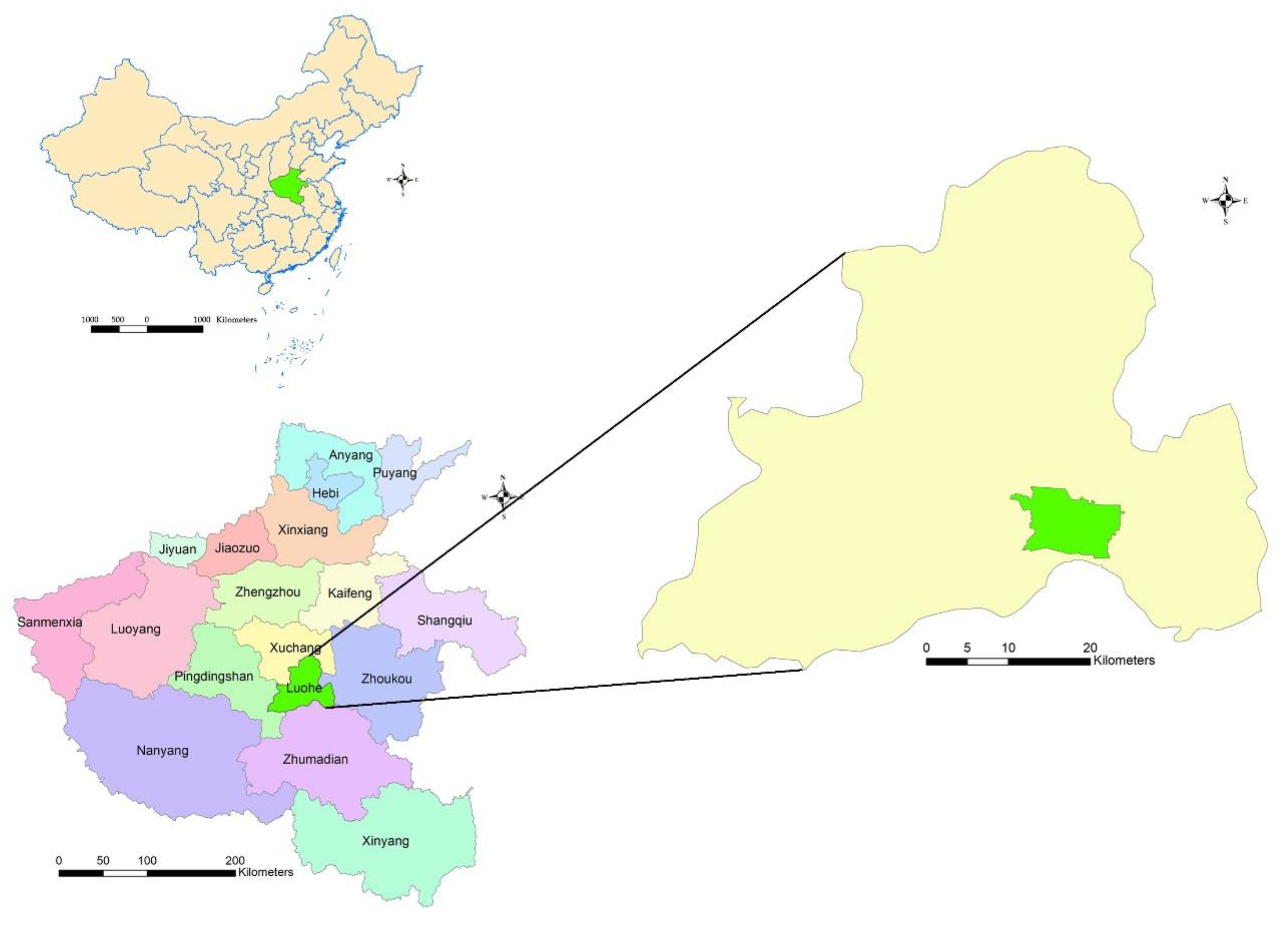
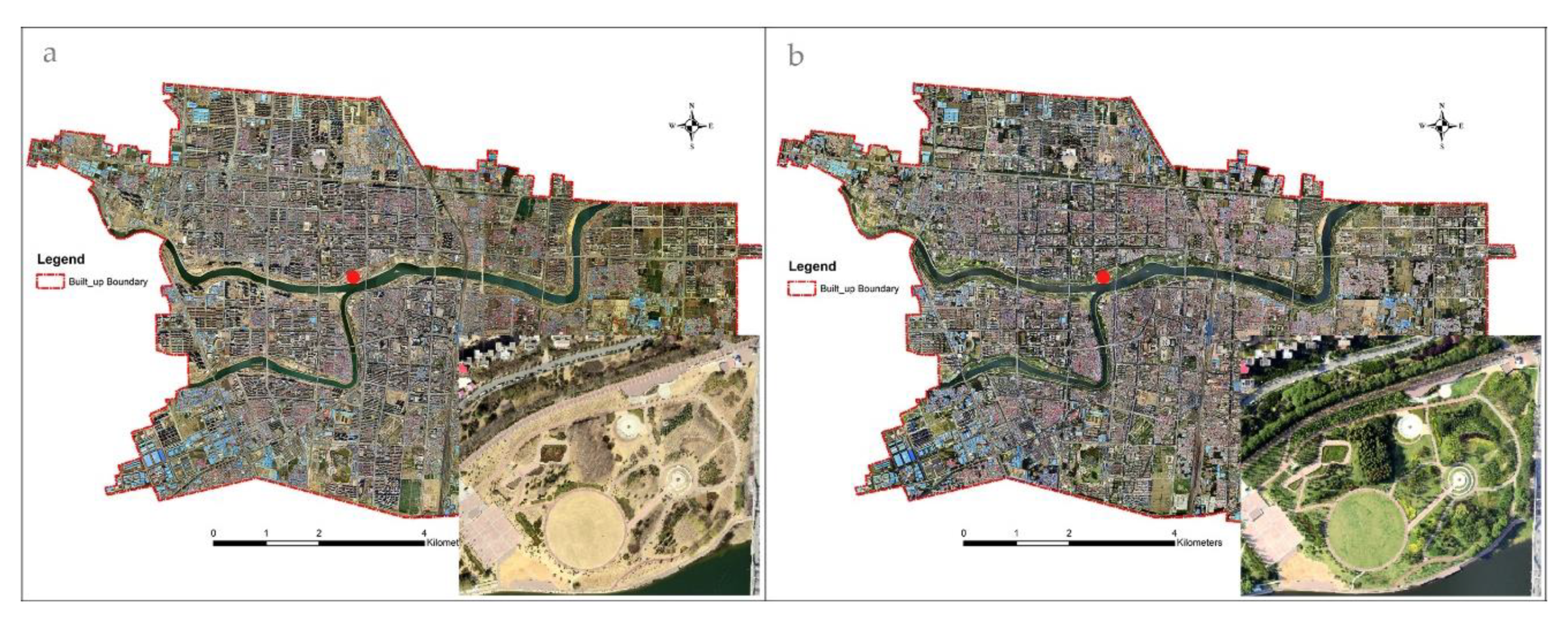
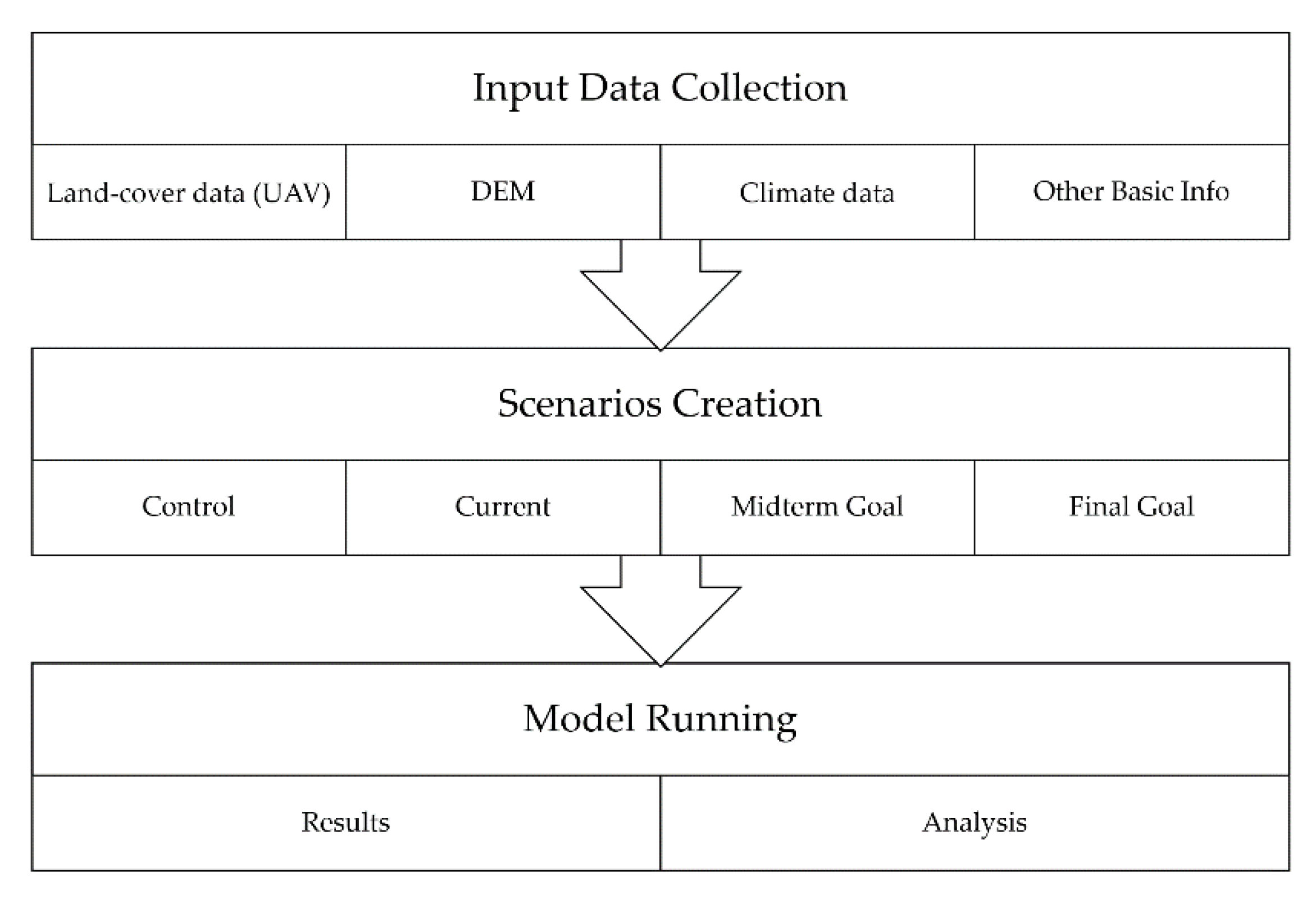
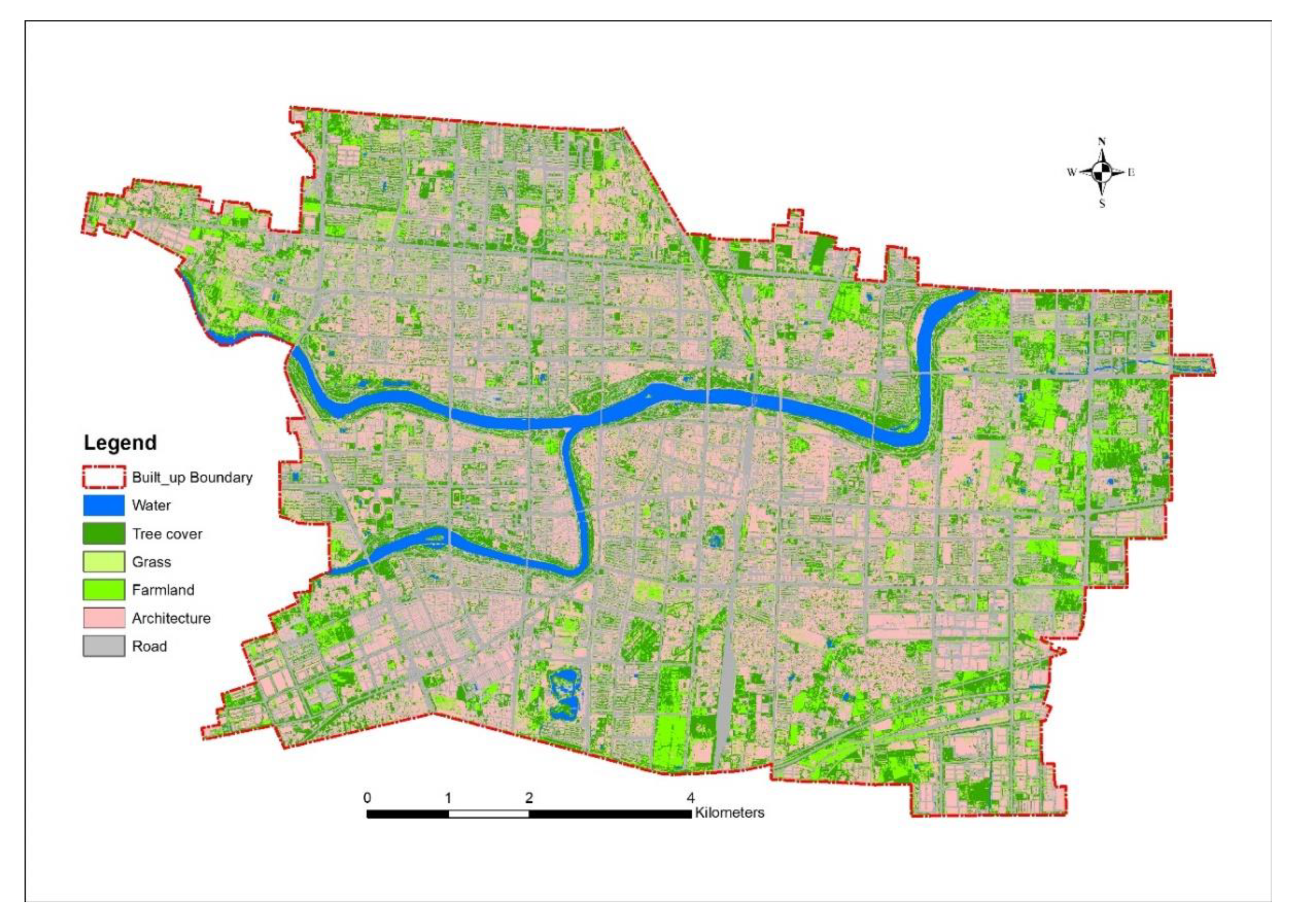
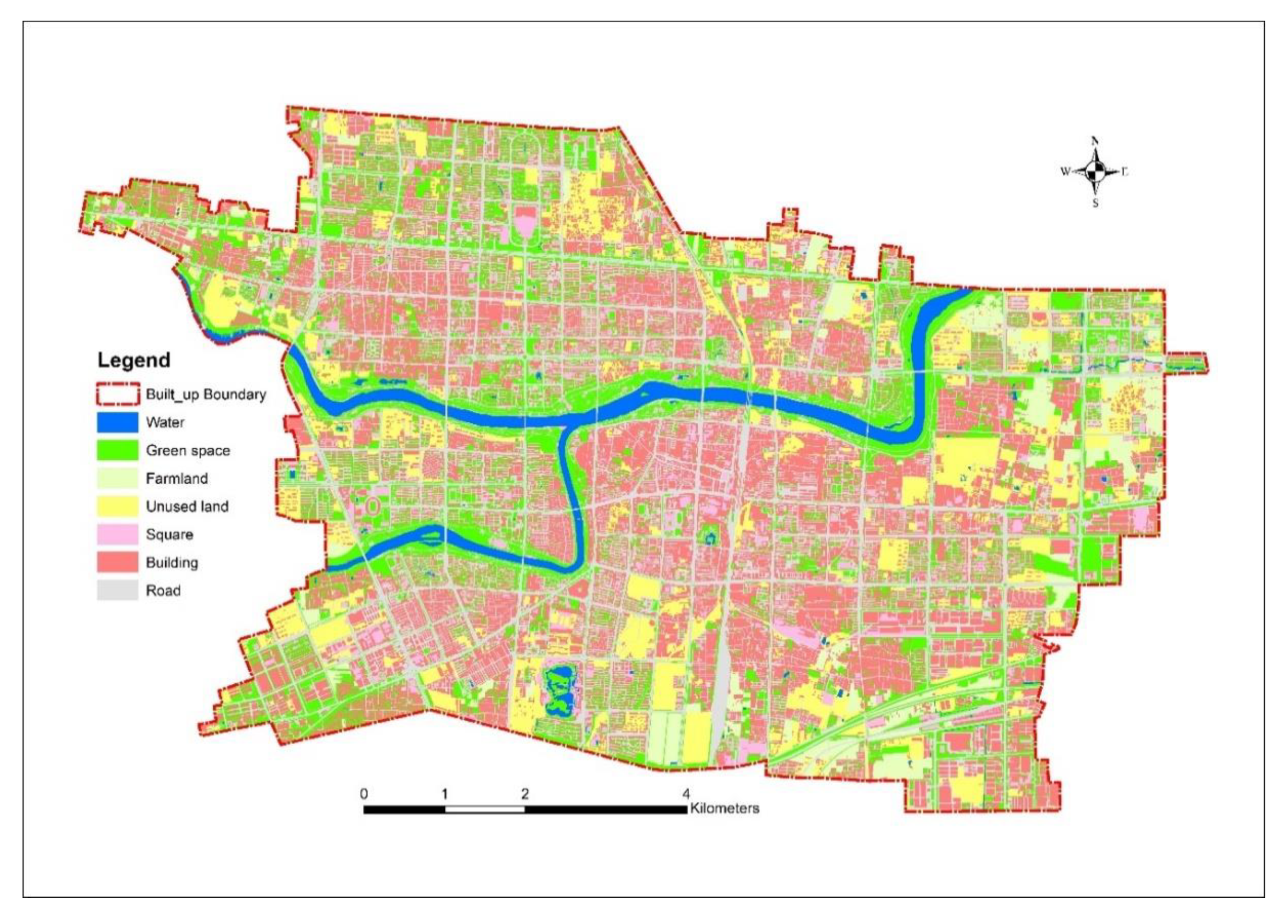
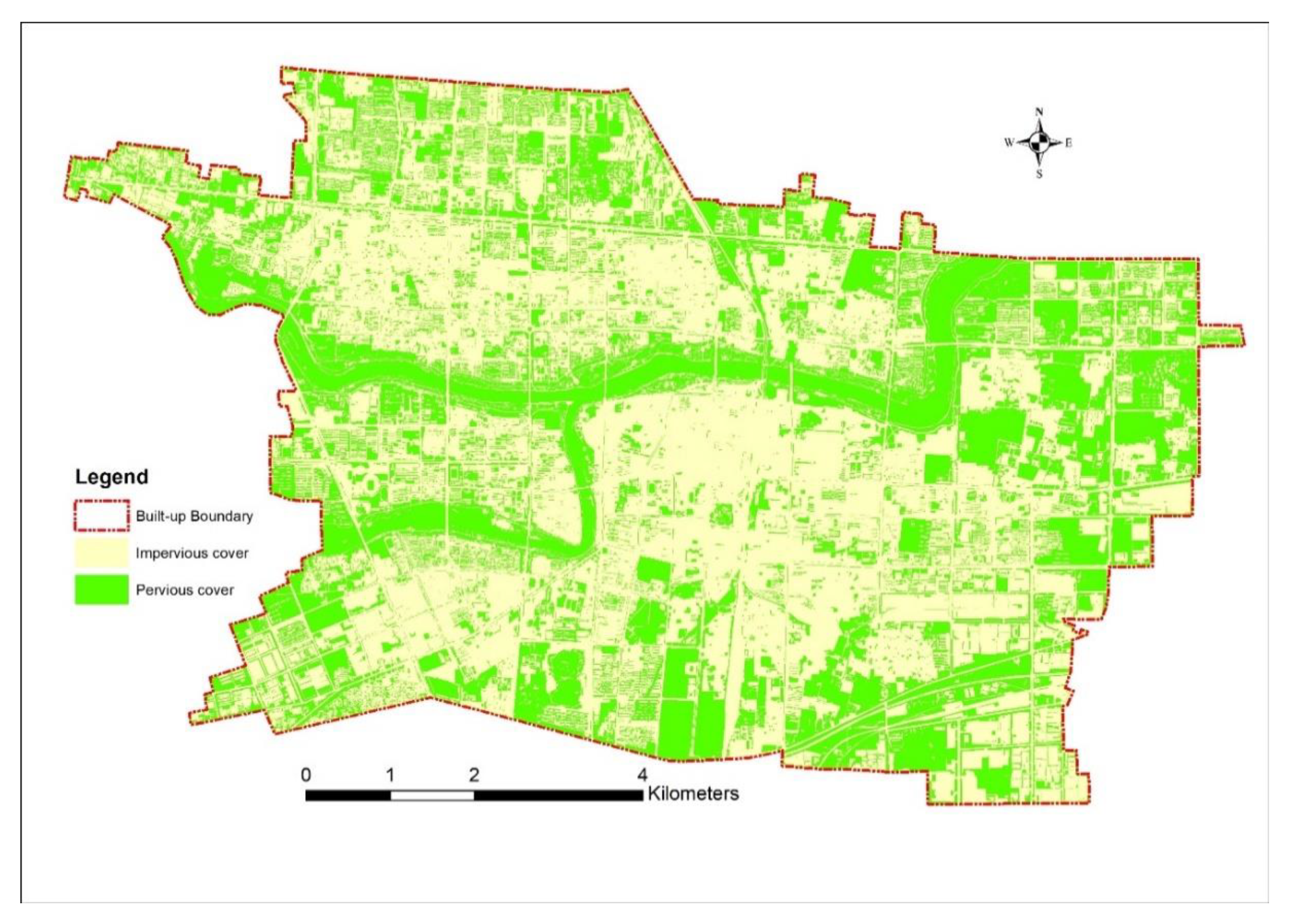
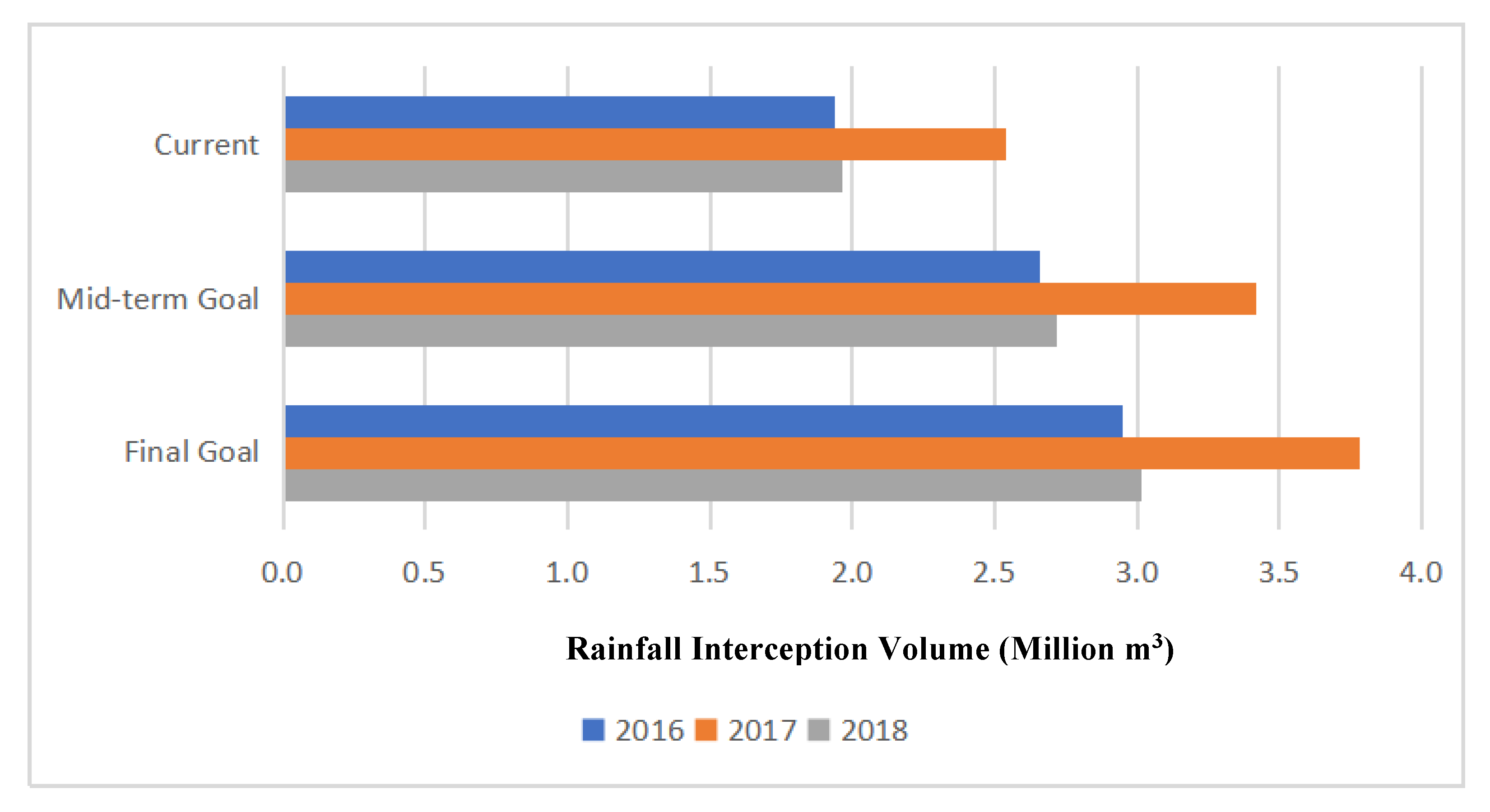
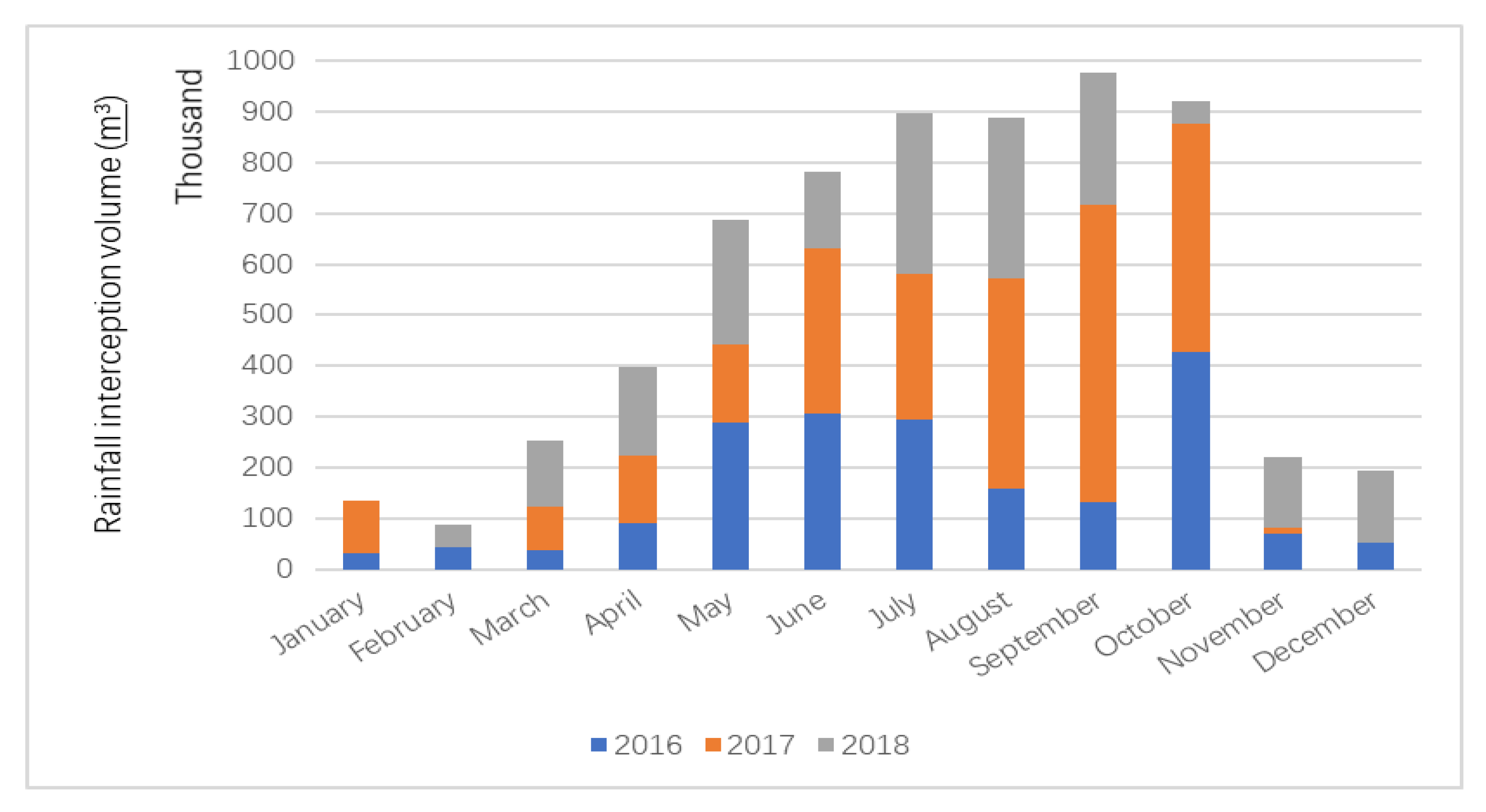
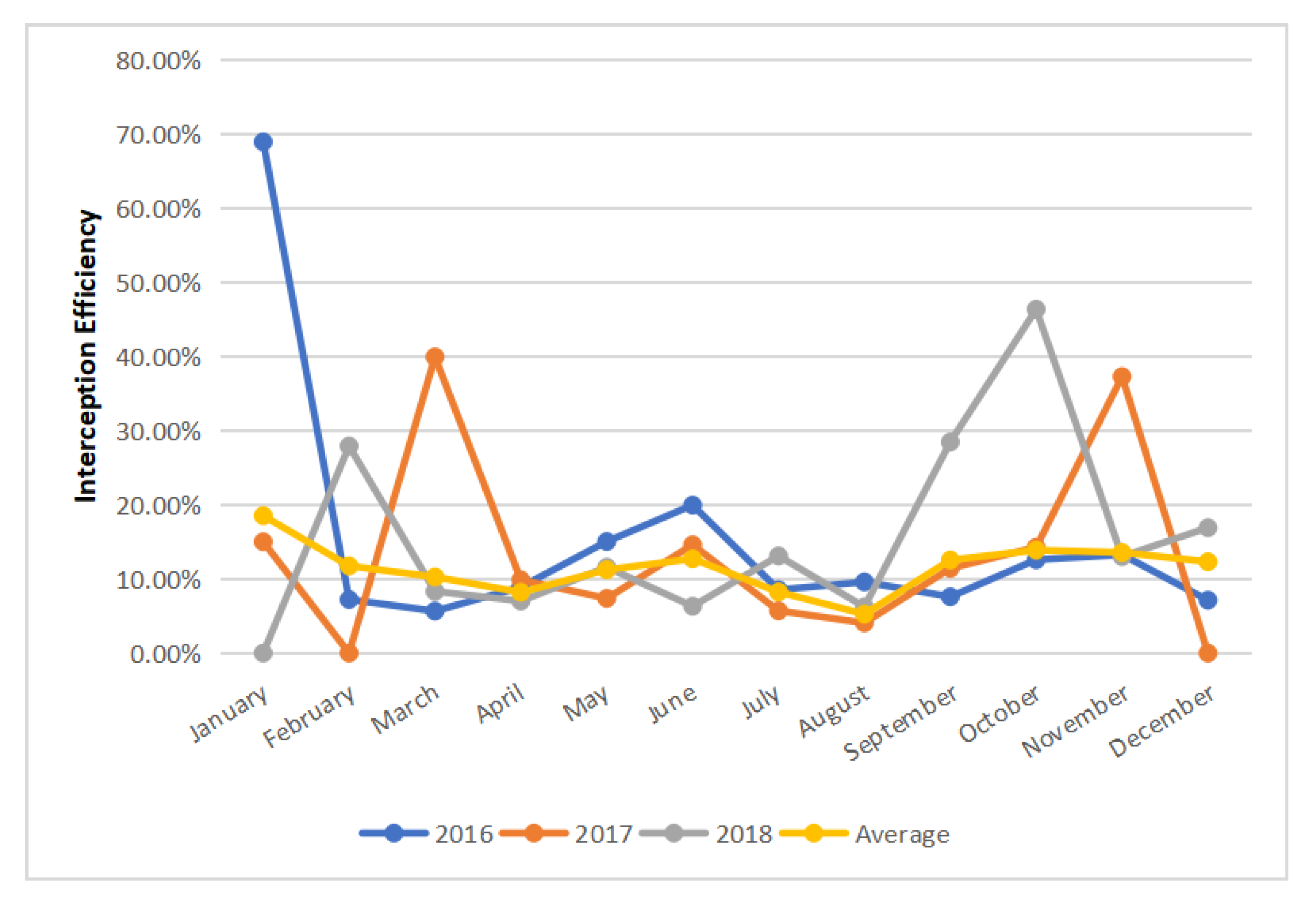
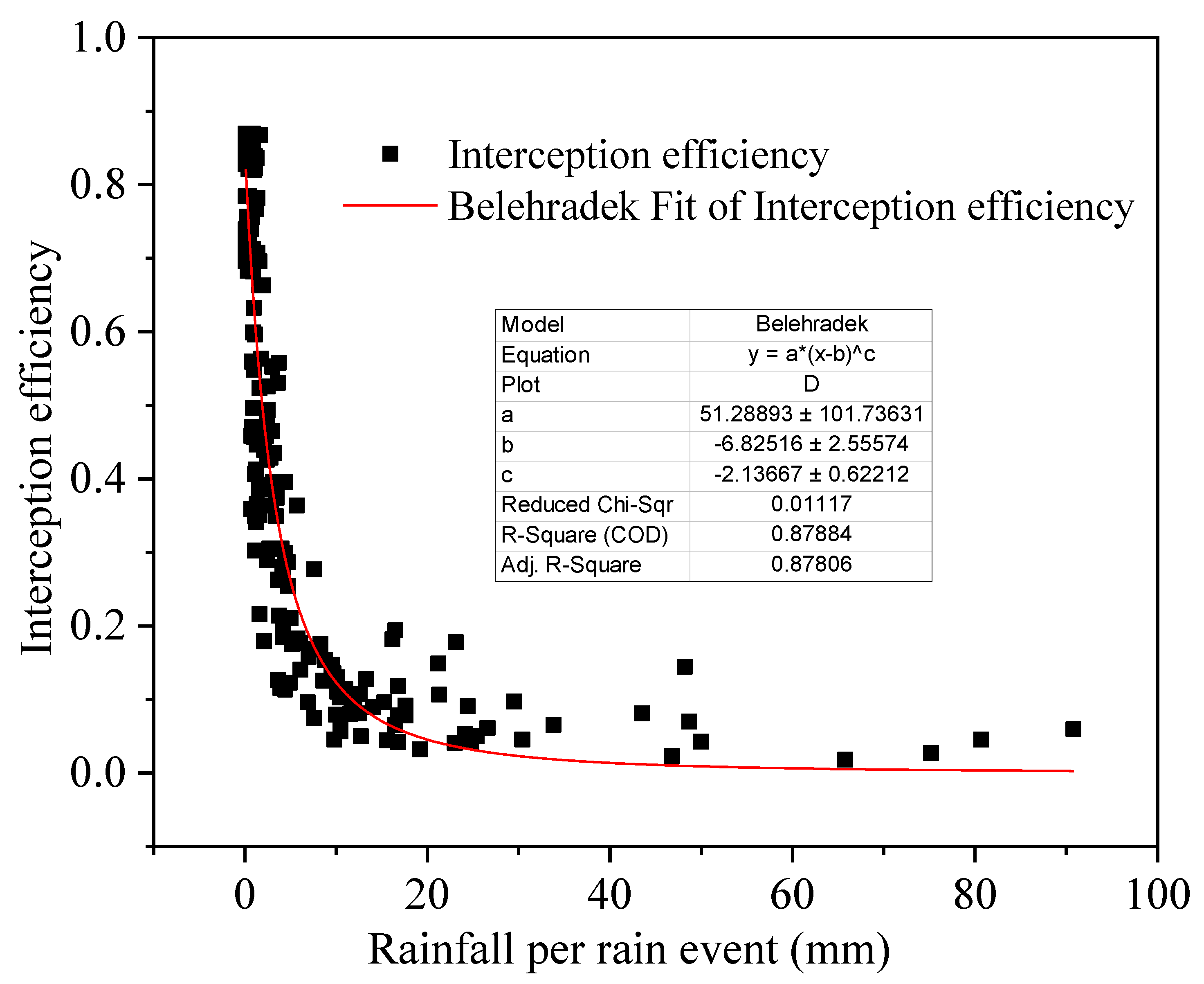
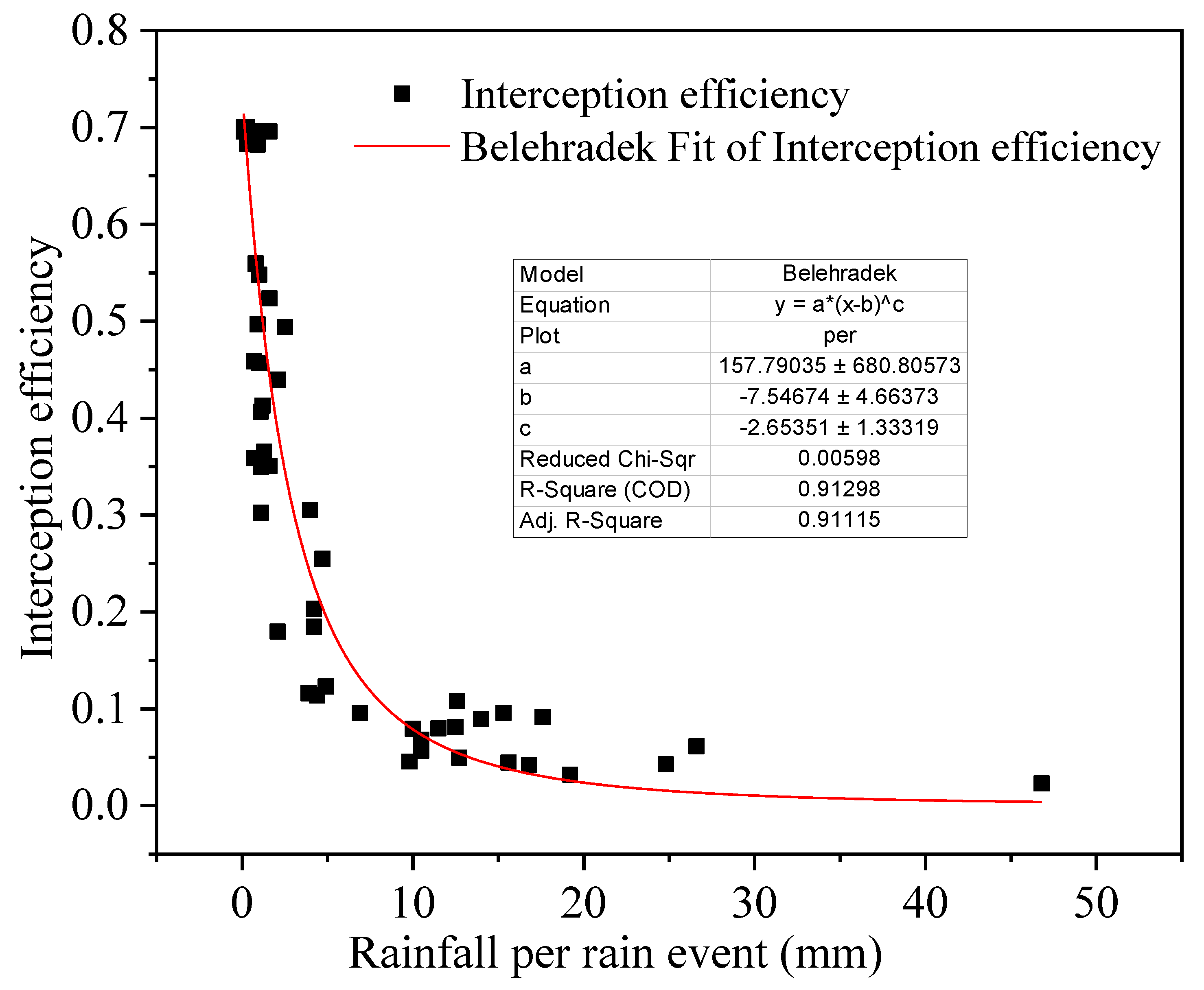
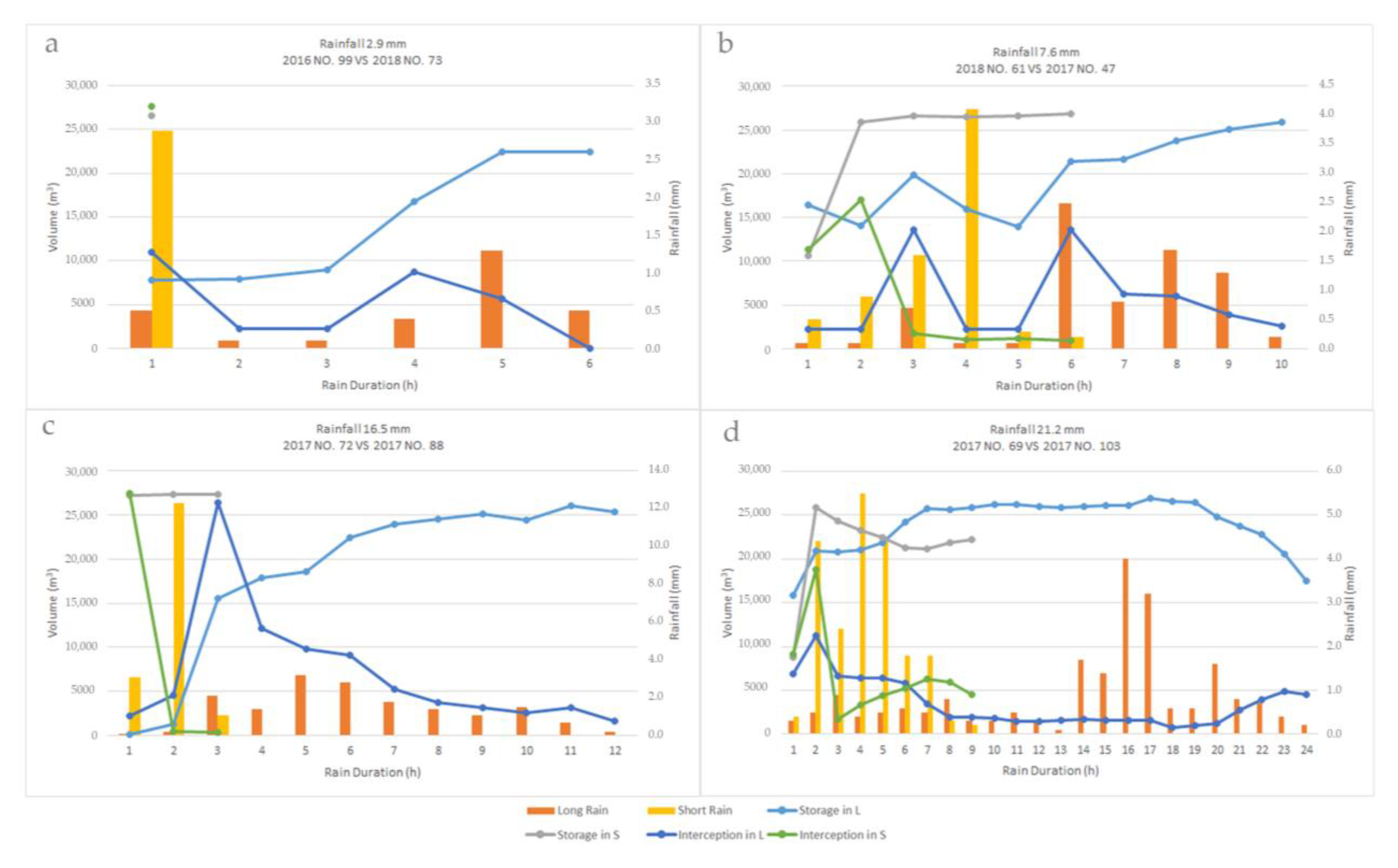
| Scenario | Canopy Cover | Shrub Cover | Herbaceous | Bare Soil | Impervious Cover | Water | Pervious under TC | Impervious under TC |
|---|---|---|---|---|---|---|---|---|
| Control | 0 | 0 | 0 | 8% | 89% | 3% | 0 | 0 |
| Current | 27% | 2% | 6% | 8% | 54% | 3% | 20% | 7% |
| Midterm Goal | 40.00% | 1.00% | 2.00% | 3% | 51.00% | 3% | 33% | 7% |
| Final Goal | 45.00% | 1.00% | 1.00% | 2% | 48.00% | 3% | 38% | 7% |
| Scenario | Total Runoff | Base Flow | Pervious Runoff | Impervious Runoff |
|---|---|---|---|---|
| Control | 161,146,805 | 289,712 | 28,446,592 | 132,406,889 |
| Current | ↘15,871,880 | ↗1,043,017 | ↗56,883,324 | ↘73,798,215 |
| Midterm Goal | ↘18,533,251 | ↗1,156,936 | ↗60,167,292 | ↘79,857,470 |
| Final Goal | ↘20,303,993 | ↗1,270,101 | ↗63,945,390 | ↘85,519,483 |
© 2020 by the authors. Licensee MDPI, Basel, Switzerland. This article is an open access article distributed under the terms and conditions of the Creative Commons Attribution (CC BY) license (http://creativecommons.org/licenses/by/4.0/).
Share and Cite
Song, P.; Guo, J.; Xu, E.; Mayer, A.L.; Liu, C.; Huang, J.; Tian, G.; Kim, G. Hydrological Effects of Urban Green Space on Stormwater Runoff Reduction in Luohe, China. Sustainability 2020, 12, 6599. https://doi.org/10.3390/su12166599
Song P, Guo J, Xu E, Mayer AL, Liu C, Huang J, Tian G, Kim G. Hydrological Effects of Urban Green Space on Stormwater Runoff Reduction in Luohe, China. Sustainability. 2020; 12(16):6599. https://doi.org/10.3390/su12166599
Chicago/Turabian StyleSong, Peihao, Jianhui Guo, Enkai Xu, Audrey L. Mayer, Chang Liu, Jing Huang, Guohang Tian, and Gunwoo Kim. 2020. "Hydrological Effects of Urban Green Space on Stormwater Runoff Reduction in Luohe, China" Sustainability 12, no. 16: 6599. https://doi.org/10.3390/su12166599
APA StyleSong, P., Guo, J., Xu, E., Mayer, A. L., Liu, C., Huang, J., Tian, G., & Kim, G. (2020). Hydrological Effects of Urban Green Space on Stormwater Runoff Reduction in Luohe, China. Sustainability, 12(16), 6599. https://doi.org/10.3390/su12166599









